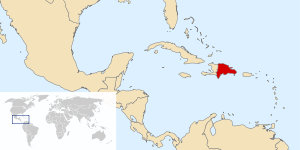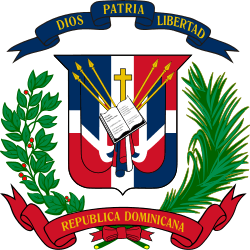Spanish occupation of the Dominican Republic
In 1861, Dominican general Pedro Santana suggested retaking control of the Dominican Republic to queen Isabella II of Spain, after a period of 17 years of Dominican sovereignty. Newly independent Dominican Republic was economically recovering from the recently ended Dominican War of Independence (1844–1856), when the Republic won its independence against Haiti. Spanish crown and authorities, which scorned and rejected the peace treaties signed after the dismantling of some of its colonies in the Spanish West Indies some 50 years prior, welcomed his proposal and set to reestablish the colony.
Spanish occupation of the Dominican Republic | |||||||||
|---|---|---|---|---|---|---|---|---|---|
| 1861–1865 | |||||||||
.svg.png) | |||||||||
 | |||||||||
| Status | Spanish colony | ||||||||
| Capital | Santo Domingo | ||||||||
| Common languages | Spanish | ||||||||
| Government | Monarchy | ||||||||
| Queen | |||||||||
• 1861–1865 | Isabella II of Spain | ||||||||
| Captain General | |||||||||
• 1861–1862 | Pedro Santana | ||||||||
• 1864–1865 | José de la Gándara | ||||||||
| History | |||||||||
• Establishment | 1861 | ||||||||
• Restoration of Dominican sovereignty | 1865 | ||||||||
| Area | |||||||||
| 48,442 km2 (18,704 sq mi) | |||||||||
| Currency | Santo Domingo peso, Spanish peso | ||||||||
| |||||||||
The end of the U.S. Civil War in 1865 and the re-assertion of the Monroe Doctrine by the United States (no longer involved in internal conflict and possessing enormously expanded and modernized military forces as a result of the war) prompted the evacuation of Spanish forces back to Cuba that same year.
Resistance
.jpg)
On July 4, 1861, former President Francisco del Rosario Sanchez was captured and executed after leading a failed invasion of Santo Domingo from Haiti. On August 16, 1863, 14 anti-annexationists led by Santiago Rodriguez Masago made a daring raid on the Capotillo Hill, where they raised the Dominican flag. Except for Santo Domingo and some of the neighboring towns, the whole country rose in arms, and several towns in Cibao joined the rebellion. Soon, 6,000 Dominican insurgents rallied to Gaspar Polanco's army, which besieged Fort San Luis and its 800-man Spanish garrison and captured it on September 13. A steam frigate went to the support of Spanish troops holed up in the fort at Puerto Plata and drove off the rebels by firing grapeshot. Self-appointed president Jose Antonio Salcedo unsuccessfully lobbied for United States aid in the war, but the guerrillas killed a total of 1,000 Spaniards by March 1864, while another 9,000 had perished from fever. The 21,000-strong Spanish garrison received 6,000 reinforcements, and Jose de la Gandara y Navarro was appointed the new Spanish commander.
La Gandara attempted to broker a ceasefire with the rebels, but Gaspar Polanco overthrew and assassinated Salcedo, who had made costly military mistakes and intended to recall the unpopular Buenaventura Baez to serve as President once more. After a failed attack on the Spanish at Monte Cristi, Polanco was overthrown by his own brother Juan Antonio Polanco, Pedro Antonio Pimentel, and Benito Moncion, who appointed Benigno Filomeno de Rojas as the new President in January 1865. By then, the American Civil War was almost at an end, frightening Spain. Queen Isabella II of Spain annulled the annexation on March 3, 1865, and, by July 15, there were no Spanish troops left on the island.
Governors
1861–1865
- 1861–1862: Pedro Santana
- 1862–1863: Felipe Ribero y Lemoine
- 1863–1864: Carlos de Vargas
- 1864–1865: José de la Gándara
